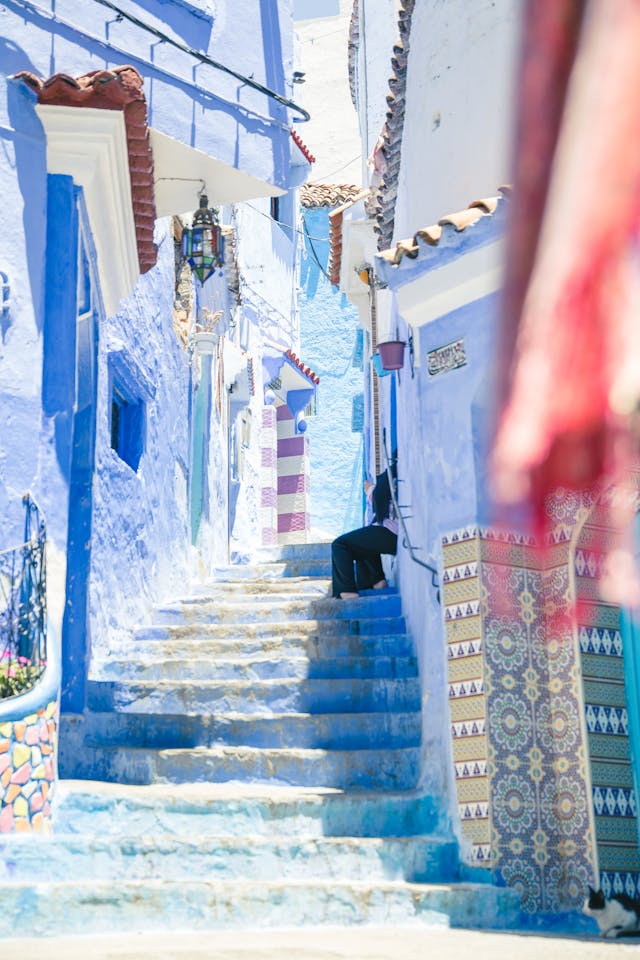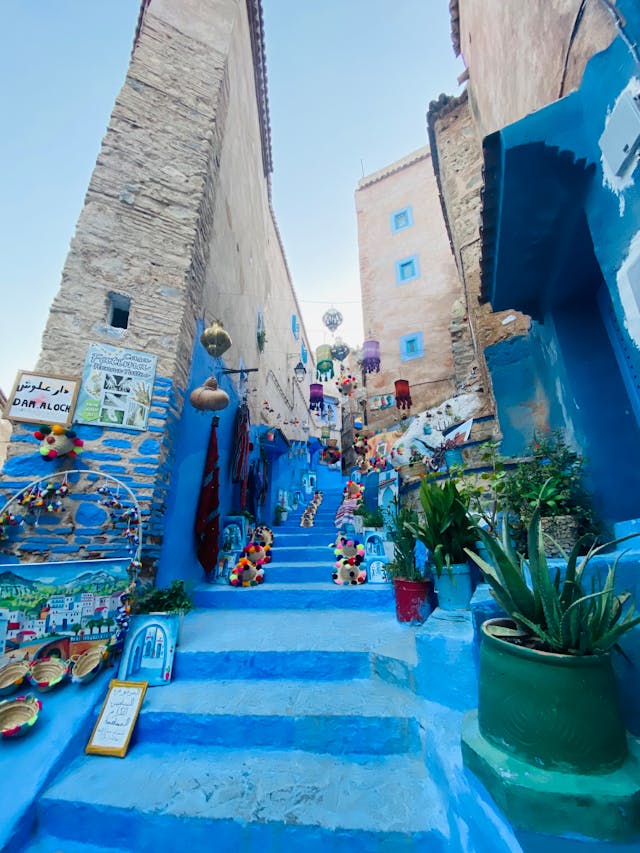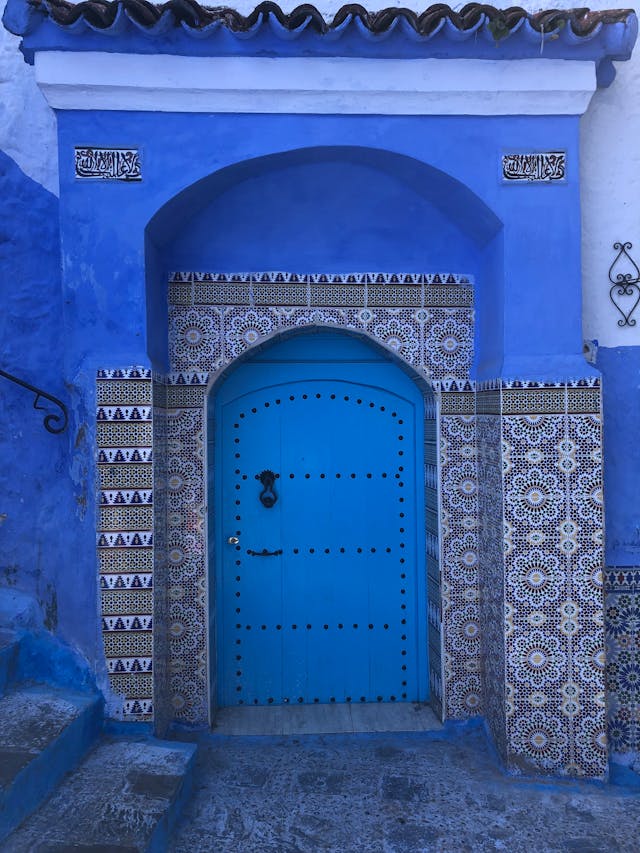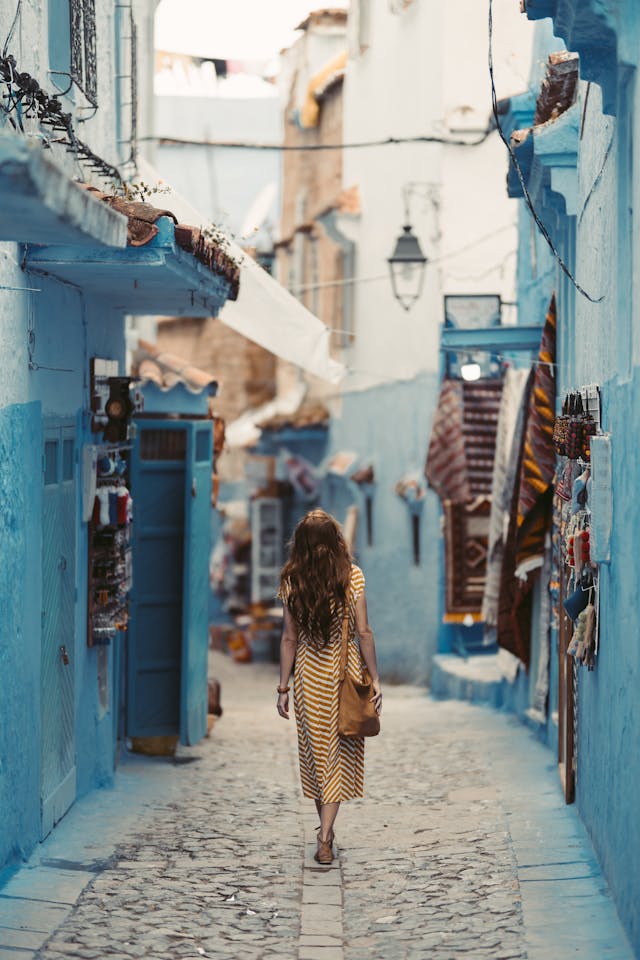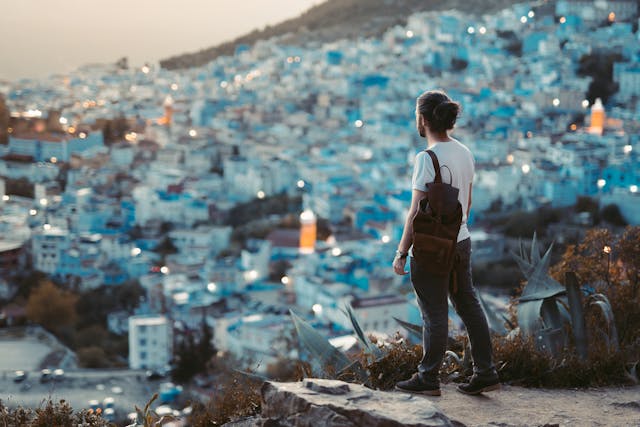
Nestled in the Rif Mountains of Northern Morocco lies the enchanting Blue City of Chefchaouen. Known as the Blue Pearl of Morocco, this picturesque city is renowned for its striking blue-washed buildings that adorn its winding streets. The city’s blue hue is said to have been introduced by Jewish refugees who arrived in the 1930s, who believed that the color blue symbolized the sky and heaven and would bring them closer to God.
The Blue City of Morocco is a popular destination for travelers seeking to immerse themselves in the country’s rich cultural heritage while enjoying breathtaking views of the surrounding mountains. Visitors can explore the city’s narrow streets, lined with vibrant blue buildings and adorned with colorful flowers and ornate doorways. The city’s bustling markets offer a range of traditional Moroccan handicrafts, including intricate textiles, pottery, and jewelry. For those seeking adventure, the nearby Rif Mountains offer a range of hiking trails and scenic vistas.
History and Origin
The blue city of Morocco, Chefchaouen, is a small town located in the Rif Mountains. Its history dates back to the 15th century when it was founded by the Berber tribes. The town’s name, Chefchaouen, is derived from the Berber word “Chaouen,” which means horns, referring to the mountain peaks that surround the town.
Founding of Chefchaouen
The town was founded in 1471 by the Berber chieftain Moulay Ali Ben Moussa Ben Rached El Alami. The town served as a strategic point for the Berber tribes to defend themselves against the invading Portuguese and Spanish forces.
Spanish Influence
In 1920, Chefchaouen was occupied by the Spanish, and it remained under Spanish rule until Morocco gained independence in 1956. During the Spanish occupation, the town underwent significant changes, including the introduction of the blue color on the buildings. The blue color was believed to keep mosquitoes away and to represent the color of the Mediterranean.
Jewish and Muslim Heritage
Chefchaouen has a rich history of both Jewish and Muslim heritage. During the Spanish Inquisition, many Jews fled to Chefchaouen seeking refuge. The Jewish community in Chefchaouen lived alongside the Muslim population in peace, and their influence can still be seen in the town’s architecture and culture.
Today, Chefchaouen is a popular tourist destination, known for its blue-painted buildings, narrow streets, and beautiful surroundings. The town’s unique blend of Berber, Spanish, Jewish, and Muslim influences has made it a fascinating cultural destination for travelers from all over the world.
What to do in Chefchaouen
Chefchaouen, also known as the Blue City, is a charming city in Morocco that offers a unique experience to its visitors. Here are some of the top things to do in Chefchaouen:
Explore the Medina
The Medina in Chefchaouen is a maze of narrow streets, alleys, and squares that are painted in shades of blue. It is a UNESCO World Heritage Site and is home to many shops, cafes, and restaurants. Visitors can wander through the Medina and discover the city’s traditional way of life.
Visit the Kasbah
The Kasbah is a fortress that was built in the 18th century to defend the city against invaders. Today, it is a museum that showcases the city’s history and culture. Visitors can explore the Kasbah’s gardens, courtyards, and rooms that are decorated with traditional Moroccan tiles and artwork.
Admire the Mosques
Chefchaouen has several mosques that are worth visiting. The Grand Mosque is the largest mosque in the city and is located in the heart of the Medina. The Spanish Mosque is another popular mosque that offers stunning views of the city and the surrounding mountains.
Experience the Religious Culture
Chefchaouen is a city with a strong religious culture. Visitors can witness the locals performing their daily prayers and rituals at the mosques and other religious sites. It is important to respect the local customs and traditions while visiting these sites.
In conclusion, Chefchaouen is a city that offers a unique blend of tradition, culture, and history. Visitors can explore the Medina, visit the Kasbah, admire the mosques, and experience the religious culture of the city.
Travel and Tourism
Getting to Chefchaouen
Traveling to Chefchaouen, also known as the Blue City, is an exciting adventure that many tourists embark on. The easiest way to get there is to fly into Tangier Ibn Battouta Airport, which is about 130 kilometers away. From there, visitors can take a taxi or a bus to Chefchaouen. Taxis are a bit more expensive, but they are faster and more convenient. Buses, on the other hand, are cheaper, but they take longer and may not be as comfortable.
Accommodations
Chefchaouen has a variety of accommodations for tourists, ranging from budget-friendly hostels to luxurious riads. Riads are traditional Moroccan houses that have been converted into hotels. They offer a unique and authentic experience for travelers. Some popular riads in Chefchaouen include Casa La Palma, Dar Sababa, and Dar Zambra.
Local Attractions
Chefchaouen is known for its blue-painted buildings, but there is much more to see and do in this charming city. Visitors can explore the medina, which is a UNESCO World Heritage Site. The medina is home to many shops and restaurants, as well as the famous Ras Elma waterfall. Other popular attractions include the Kasbah Museum, the Spanish Mosque, and the Outa El Hammam Square.
For those who want to venture outside of the city, there are many day trip options available. Visitors can take a hike in the nearby Talassemtane National Park, visit the Roman ruins of Volubilis, or explore the coastal city of Tangier.
Overall, Chefchaouen is a must-visit destination for travelers who want to experience the beauty and culture of Morocco. With its stunning blue buildings, rich history, and welcoming locals, it is sure to leave a lasting impression on any tourist.
Chefchaouen’s Blue Streets
Nestled in the Rif Mountains of Morocco, Chefchaouen is a picturesque city known for its blue streets. The city’s blue walls and buildings have attracted visitors from all over the world, making it a popular destination for photographers and Instagram enthusiasts.
The Significance of Blue
The blue color of the streets and buildings in Chefchaouen is said to have originated from Jewish refugees who settled in the city in the 1930s. They painted the buildings blue as a symbol of the sky and heaven, reminding them of God’s power and protection. Over time, the blue color became a significant part of the city’s identity and culture.
Exploring the Medina
Chefchaouen’s medina, or old town, is a maze of narrow streets and alleyways, all painted in varying shades of blue. Visitors can spend hours wandering the streets, admiring the beautiful architecture and taking in the vibrant colors. The medina is also home to many shops and markets, selling everything from handmade crafts to local delicacies.
Instagrammable Spots
For those looking to capture the perfect Instagram photo, Chefchaouen’s blue streets offer endless opportunities. Some of the most popular spots include the blue staircase near the Ras El Ma river, the blue alleyway near the Grand Mosque, and the blue arches at the entrance to the medina. Visitors can also climb to the top of the hill overlooking the city for a stunning panoramic view.
Overall, Chefchaouen’s blue streets are a unique and beautiful sight to behold. Whether you’re a history buff, a photographer, or just looking for a new adventure, this Moroccan city is definitely worth a visit.
Activities and Experiences
Blue City Morocco offers a wide range of activities and experiences for visitors to enjoy. From shopping and markets to hiking and nature trails, there is something for everyone.
Shopping and Markets
The city is known for its vibrant markets and souks, where visitors can find a variety of traditional Moroccan goods such as spices, textiles, and pottery. The most popular market is the Chaouwara Tanneries, where visitors can watch leather being dyed and processed.
Hiking and Nature Trails
For those who enjoy the great outdoors, Blue City Morocco has plenty of hiking and nature trails to explore. The Akchour Waterfalls, located in the Talassemtane National Park, is a popular hiking destination. The park also offers stunning views of the Rif Mountains and is home to a variety of wildlife.
Culinary Delights
Blue City Morocco is known for its delicious cuisine, which combines Berber, Arab, and Mediterranean influences. Visitors can sample traditional dishes such as tagine, couscous, and pastilla at local restaurants. One of the best places to try Moroccan cuisine is at Restaurant Tissemlal, which offers a range of authentic dishes in a cozy atmosphere.
Overall, Blue City Morocco offers a unique and unforgettable experience for visitors. Whether you’re interested in shopping, hiking, or trying new foods, there is something for everyone to enjoy in this vibrant city.
Practical Information
Best Time to Visit
The best time to visit Blue City Morocco is during the spring months of March to May, or in September and November. During these months, the weather is mild and comfortable, making it perfect for exploring the city and its surroundings. The summer months of June to August can be very hot, while the winter months of December to February can be quite cold and rainy.
Transportation Options
The most convenient way to get to Blue City Morocco is by bus. CTM Bus is a reliable and affordable option that operates daily from major cities in Morocco. Renting a car is also an option for those who prefer to have more flexibility and control over their itinerary.
Travel Tips
When visiting Blue City Morocco, it is important to dress appropriately and respectfully. Women should avoid wearing revealing clothing, while both men and women should cover their shoulders and knees when visiting religious sites. It is also recommended to purchase travel insurance to protect against any unexpected incidents or emergencies.
Overall, Blue City Morocco is a beautiful and unique destination that is worth exploring. By following these practical tips, visitors can make the most of their trip and have a memorable experience.
Frequently Asked Questions
What is the historical significance of Chefchaouen’s blue walls?
The blue walls of Chefchaouen are believed to have been painted by Jewish refugees who fled from Europe during the 1930s. The color blue was traditionally associated with the Jewish faith and is thought to represent the sky and heaven. The blue walls have since become a symbol of the city and attract many tourists each year.
How can one travel from Marrakech to the blue city in Morocco?
There are several ways to travel from Marrakech to Chefchaouen. One can take a bus, a shared taxi, or a private car. The journey takes approximately 7-8 hours by bus or shared taxi and around 5-6 hours by private car.
What are the top attractions to visit in Chefchaouen?
Some of the top attractions in Chefchaouen include the Kasbah Museum, the Ras Elma Park, the Spanish Mosque, and the Outa El Hammam Square. Visitors can also explore the narrow alleys of the city’s medina, shop for handicrafts, and enjoy the local cuisine.
Are there guided tours available in the blue city of Morocco?
Yes, there are many guided tours available in Chefchaouen. Visitors can choose from a variety of tours that cover different aspects of the city’s history, culture, and traditions. Some tours also include visits to nearby attractions such as the Akchour Waterfalls and the Talassemtane National Park.
What accommodations are recommended for staying in Chefchaouen?
There are many accommodations available in Chefchaouen, ranging from budget-friendly hostels to luxury hotels. Some popular options include the Dar Echchaouen, the Casa Perleta, and the Lina Ryad & Spa.
How did the blue city in Morocco respond to the recent earthquake?
In 2020, a 5.8 magnitude earthquake hit the region near Chefchaouen. Although the city was not directly affected, many residents and visitors felt the tremors. The local authorities responded quickly to the earthquake and ensured that the necessary measures were taken to ensure the safety of everyone in the city.
Tags: Blue City Morocco

